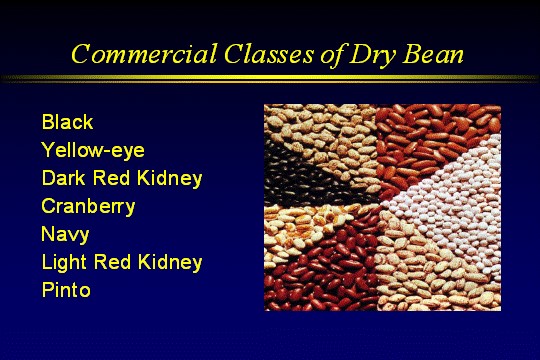Program Objectives
Dry Bean (Phaseolus vulgaris) Breeding and Genetics Program
Principal Investigator: Valerio Hoyos-Villegas; Plant, Soil and Microbial Sciences, Michigan State University
The dry bean program focuses on the breeding of navy, black, pinto, great northern, small red, light red kidney, dark red kidney, white kidney, cranberry, pink and yellow bean market classes for yield, adaptation, plant architecture, disease resistance, stress tolerance, canning quality, and sustainable production largely in Michigan (Kelly, 2000)[1]. Since its inception in the early 1900’s the program has released 62 dry bean cultivars in eleven commercial classes and participated in the release of 85 germplasm lines. Different bean classes present unique and challenging problems for the improvement of yield, quality, disease resistance and plant architectural traits. Upright types suited for direct harvest have been developed in all Middle American market classes. Since kidney and cranberry beans belong to the Andean gene pool that is genetically distinct from Middle American gene pool (navy, black, pinto beans), the effective utilization of Middle American germplasm as genetic donors for improvement in kidney and cranberry beans has been hindered by gene pool incompatibilities. Breeding methods that optimize integration between gene pools and the wild species have been investigated (Acosta et al., 2007; Kelly, 2004).
One major focus of the program has been the study of the disease resistance in the same ten commercial classes. The major pathogens endemic in the humid Midwest include rust, anthracnose, mosaic virus, white mold, root rots and common bacterial blight. Pathogenic variability and the occurrence of new races of common pathogens (Balardin et al., 1997) combined with a lack of adequate levels of genetic resistance in certain bean classes is a major research challenge. To facilitate breeding for disease resistance, molecular markers tightly linked to the different resistance genes have been developed to permit gene pyramiding and allow for simultaneous selection of multiple disease resistance. Our research group has successfully identified SCAR markers tightly linked to over 10 major resistance genes that control resistance to three pathogens (Kelly et al., 2003). Since many resistance traits are complex and quantitatively inherited, research to develop other marker systems associated with the quantitative trait loci (QTL; Kelly and Vallejo, 2005) controlling resistance to white mold (Ender et al., 2008), root rots (Roman and Kelly, 2005), common bacterial blight (O’Boyle et al., 2007) and drought (Frahm et al., 2004) has been conducted by graduate students in the program. Our current focus is on the refinement of marker-aided breeding using SNP, InDel and KASP markers for disease resistance, drought tolerance and nutrient content in beans in collaboration with the BeanCAP project. Traits such as nitrogen fixation of importance in organic bean production systems are being investigated. Current graduate student research projects are focused in the area of genomics related to the breeding for tolerance to biotic and abiotic stresses, insect pests and improved N-fixation in bean.
Since beans are consumed directly by humans, they must meet minimum standards for both dry seed and processed seed quality. Over 90% of navy and kidney beans are canned and an increasing large percentage of pinto, small red and great northern beans are now processed. In addition to selection for dry seed traits such as size, shape, and color, all new breeding lines are canned and evaluated for processing characteristics. These characteristics include: hydration ratio, washed drained weight ratio, shear press texture, processed color, and color retention in black beans. The complex inheritance of these traits coupled with the delay due to inbreeding prior to evaluation suggests the possibility of developing linked markers to assist in the early generation selection for improved processing quality (Wright and Kelly, 2011; Posa-Macalincag et al., 2002). Nutrient content is being investigated in collaboration with colleagues in the BeanCAP project.
Current international research activities funded through the Legume Innovation Lab are focused on the use of marker-assisted selection and participatory plant breeding for drought tolerance, enhanced nitrogen fixation and disease resistance in bean production regions of Ecuador, Rwanda, Uganda and Zambia. Interested students have the opportunity to conduct research overseas.
[1] Literature cited is listed under publications.




 Print
Print Email
Email